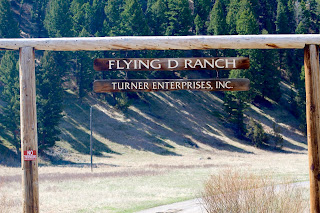#LEAD2BigSky Day 6: Flying D Ranch and Environmental Agriculture
Ted Turner is known for launching CNN, TBS, being the owner of the Atlanta Braves and for launching Turner Enterprises, among other entrepreneurial pursuits. What many may not realize is, he also owns 2.2 million acres globally, spread across ranches and plantations, which is more land than the entirety of Yellowstone National Park. One of these ranches is located in southwest Montana, Flying D Ranch. We were blessed with an opportunity to tour this 115,000-acre operation, which is home to 5,500 head of bison.
Bison Bull from Flying D Ranch
As we toured the property, ranch manager Danny Johnson shared some fascinating details about the bison herd. This bison operation can grow to 7,500 head during the calving season. These bison even have an astounding 96% conception rate. The herd is rotating from pasture to pasture in order to properly manage grassland resources. Also, four of the famous Ralphie the Buffalo, the mascot of the University of Colorado Buffaloes, have come from Flying D Ranch.
Video of Ralphie the Buffalo
In addition, 2,000 head of bison is harvested each year and is sold for around $4.60/lb of meat.
When Ted Turner began this endeavor, the market for bison meat was incredibly low. Seeing this as an opportunity, he started Ted’s Montana Grill, a restaurant chain focusing primarily on bison meat. However, while he could have monopolized on this idea, Turner took this opportunity to bolster the entire bison meat market and help it to grow.
Flying D Ranch has signed a lifelong agreement with the Nature Conservancy to practice conservation and ecosystems management. This agreement was written due to the incredible amount of biodiversity on the property. On the 175 square mile ranch, there are active and healthy populations of free-ranging elk, white-tailed deer, mule deer, pronghorn, moose, grizzly bear, black bear, and wolf. The ranch has a full-time wolf biologist on staff to help monitor and research the population and impact. Under the Nature Conservancy easement, the land can never be developed due to the importance of the land. In the winter, the Yellowstone National Park elk populations migrate the 70 miles to the property. Through all of this, this property holds a healthy and sustainable Montana ecosystem.
Besides the agriculture production, the ranch also has environmental production too with guided hunts and timber production. They practice active forest management with prescribed burning and timber cuts. This to help support the natural ecosystem cycle while also making money. The do a helicopter logging method where a helicopter will come and lift the tree after being cut to prevent the use of skidders and preserve the land.
The ranches guided elk hunts bring in another huge part of the overall income, with a single elk hunt costing $14,000. There is currently a 3-year waiting list for an elk hunt because of the ranches management strategy. They only harvest 5% of the bulls on the property to help keep a healthy and sustainable population. With 2 yearly aerial wildlife surveys, they can keep an accurate population estimate and make proper harvest plans with the number of tags.
Flying D Ranch has plans to begin promoting and developing ecotourism on the property in the near future. This is such an important concept because of the uniqueness of the property. There is active environmental management, conservation, and environmental production being done with agricultural production. That healthy balance is so important and is a critical education piece. Everywhere in the country, agriculture and environmental management are not actively practices together. Flying D Ranch can be a model to show how agriculture and the environment can work together and be sustainable.
Brandon Witmer and Thomas Gabel
LEAD Society
Domestic Study Away Experience
#LEAD2BigSky






Comments
Post a Comment